Sightings of new sharks lead to MORE Spanish beach closures – hammerhead and basking sharks now spotted by tourists after 3-metre beast terrified swimmers in Gran Canaria
New shark sightings have forced two more Spanish holiday beaches to close as a number of predators have been spotted off the coast of Gran Canaria, including a beast as large as 3 meters.
Lifeguards pulled swimmers out of the water at Melenara Beach on the island’s east coast for a second day in a row when a police drone spotted a hammerhead shark from the beach shortly after it reopened yesterday morning.
The swimming ban was extended to neighboring Salinetas beach yesterday afternoon.
And about two hours later, lifeguards raised the red flag at a third spot – San Augustin beach in the south of the island – after a tourist photographed the telltale fin of a shark sticking out of the water.
It was not immediately clear whether the large fish was the same one that terrorized swimmers at Melenara beach around 5pm on Saturday and led to the first of the beach closures.
Lifeguards pulled swimmers out of the water at Melenara Beach on Gran Canaria’s east coast for the second day in a row when a police drone spotted a hammerhead shark off the beach
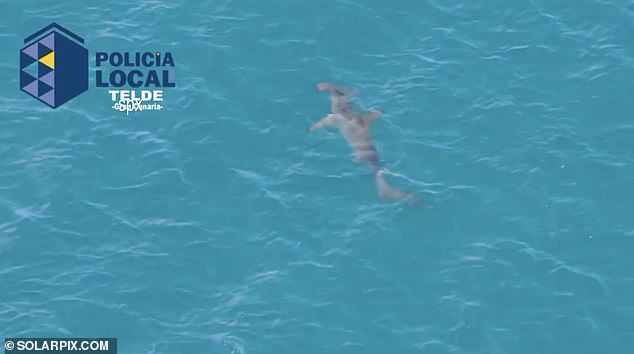
Hammerhead sharks can grow up to 6 meters long and weigh up to 1000 kilos
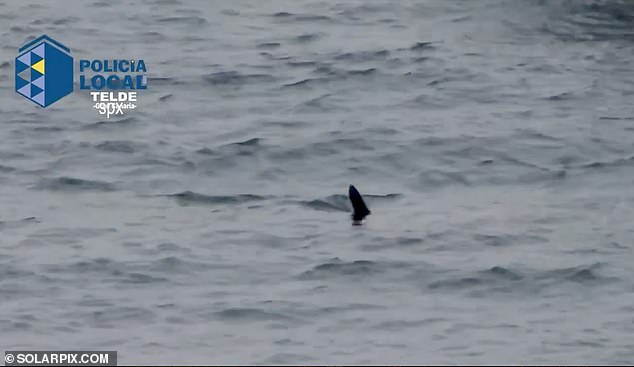
Police drone footage shows a fin sticking out of the water off the east coast of Gran Canaria
It briefly reopened for swimming yesterday morning before the second closure around 1pm, after local police drones spotted a shark near Taliarte Harbour, next to Melenara Beach.
The red flag was also raised on Salinetas beach, just south.
Local police confirmed after a second much clearer drone sighting in the same area around 5pm yesterday that it was a hammerhead shark, the same species that caused panic on Saturday when it appeared close to the coastline.
Its size was initially estimated at just under two meters, although the second drone sighting indicated it was as long as three meters.
In between, San Augustin beach, 20 miles south, was also closed after another shark sighting.
It was reportedly spotted by a tourist near a restaurant overlooking the sea called Balcon de San Augustin. Red Cross officials later confirmed they had seen it too.
It was not picked up again despite efforts by local police and other officials to locate and track it, and the beach is expected to reopen today unless council chiefs make a last-minute U-turn.
It’s not clear whether the shark we see further south is a hammerhead shark, which can grow up to six meters long and weigh up to 1,000 kilos, or another species.
Most hammerhead shark species are considered harmless to humans and few attacks have been recorded, but they are aggressive hunters and their size and ferocity make them potentially harmless.
Young girls were heard screaming as the shark that caused panic at Melenara Beach on Saturday afternoon approached the shoreline at high speed with its telltale fin sticking out of the water.
Footage from the scene showed young people running for safety as the shark swam towards the shoreline before returning at the last minute after wandering in the water.
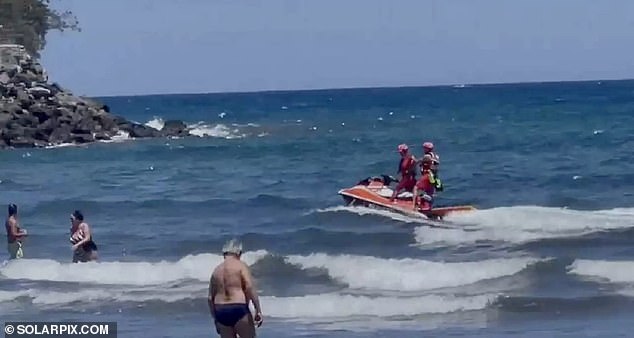
Lifeguards are seen patrolling a beach amid a spate of shark sightings, forcing tourists out of the water

Youths were seen running for safety as the shark approached around 5pm on Saturday
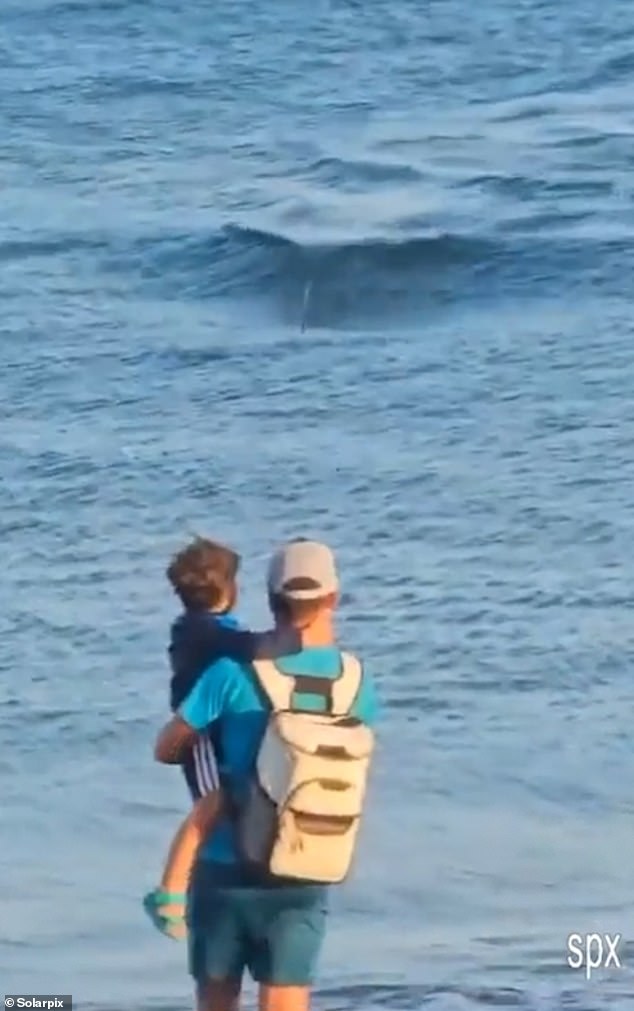
One fish was identified locally as a hammerhead shark, which can grow up to 20 feet long and weigh as much as 1,000 pounds.
Another man was pictured carrying a child in his arms from the safety of the sand as he watched it come towards them.
A municipal spokesperson for Telde Council, the municipality that includes Melenara Beach, said as the tragedy unfolded: “It is important that people remain calm and follow the instructions of lifeguards and authorities.”
A young girl who was in the water when the shark appeared told a local TV station: ‘The lifeguard started blowing his whistle and signaling for everyone to get out of the water. I looked around and saw his fin.”
A friend added: ‘We saw the fin which was about eight inches out of the water and we started moving back towards the beach as fast as we could.’
Last month, tourists and locals were banned from entering the sea after a shark sighting off a Menorcan beach.
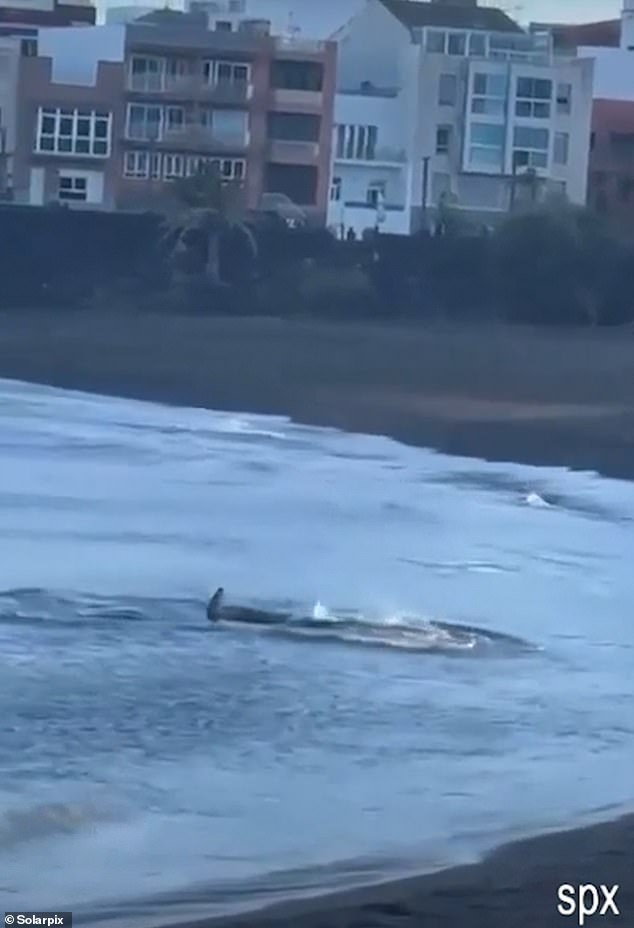
Footage from the scene showed the shark swimming towards shore before returning
Coastguards raised the red flag and shouted the Spanish equivalent of 999 after the telltale fin of a two-metre blue shark, or tinterora, was spotted above the waterline.
On May 6, the alarm was raised at around 3:30 p.m. on the popular Arenal d’en Castell beach, the same place where another shark was spotted in June 2018 when swimmers were also banned from entering the water all afternoon.
The shark sighting was described at the time as the first so far this year near a Costa beach.
Blue sharks rarely bite humans, but have been involved in several biting incidents, four of which are believed to have ended fatally.
A blue shark was blamed for an attack on a holidaymaker in Elche near Alicante in July 2016.
The 40-year-old victim was rushed to hospital and stitched up for a wound in his hand.
First aid workers described the bite as ‘large’ and said it had come from the sea with blood pouring from the wound.
In June last year, an adult blue shark measuring around two meters in length caused panic at the Costa Blanca beach of Aguamarina in Orihuela Costa, south of Alicante.
Swimmers were filmed trying to run through waist-high water to safety as it approached the shoreline.
Lifeguards blew their whistles to warn locals and holidaymakers of the big fish and urge them to leave the sea as quickly as possible.
One woman, believed to be an elderly person who was helped out of the water by Good Samaritans, is said to have had a panic attack after realizing the shark was next to her.
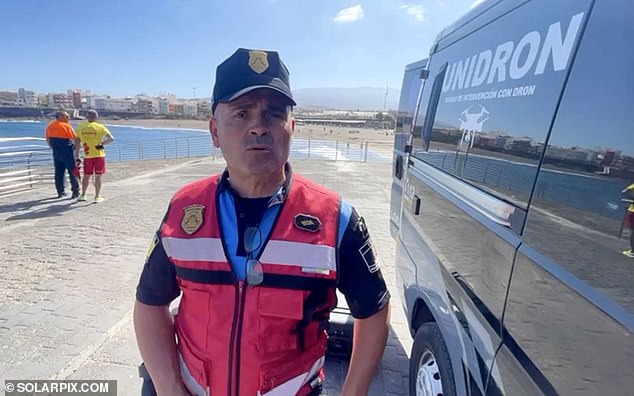
Local police confirmed after a second much clearer drone sighting in the same area around 5pm yesterday that it was a hammerhead shark, the same species that caused panic on Saturday
It washed up dead the next day at La Caleta beach in Cabo Roig, a few kilometers away.
The same day it emerged that the same shark species had been spotted in the port of Ciutadella in Menorca.
Biologist Asier Furundarena emphasized after the weekend sightings in Gran Canaria that there was no reason to worry.
He said: ‘People should respect the instructions given to them by lifeguards and local police or other authorities present and remain calm because absolutely nothing will happen to them.
‘They should also enjoy the moment they witness, because it is a privilege to see species like this that are endangered in other parts of the world and can find refuge here.’
